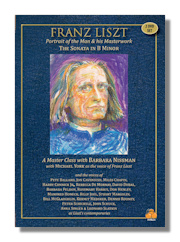
The Internet's Premier Classical Music Source
Related Links
- Liszt Reviews
- Latest Reviews
- More Reviews
-
By Composer
-
Collections
DVD & Blu-ray
Books
Concert Reviews
Articles/Interviews
Software
Audio
Search Amazon
Recommended Links
Site News
 DVD Review
DVD Review
Franz Liszt

Portrait of the Man and His Masterwork, the Piano Sonata in B minor
- Michael York (Liszt)
- John Schuck (Wagner)
- Leonard Slatkin (Schumann)
- Rebecca de Mornay (Clara Schumann)
- Rosemary Harris (Princess Carolyne)
- Billy Joel (Chopin)
- Stuart Margolin
- Bill McGlaughlin
- Barbara Feldon
Barbara Nissman, piano
Three Orange Recordings DVD 3OR-21 3:54:09 2DVDs
Summary for the Busy Executive: Nineteenth-century Elvis.
Even at this late date, a whiff of the guilty pleasure hangs about Liszt. It was, of course, truer sixty years ago, when I first consciously encountered his music. I first loved the virtuosity, the over-the-top showmanship of his more flamboyant paraphrases. But I never really took him seriously as a composer, although I recognized his historical importance, especially to musical modernism. Without Liszt, we wouldn't have had Wagner, Debussy, or the Russian School. Liszt seemed to know almopst every composer worth knowing, championing such greats as Berlioz, Wagner, and even Grieg. I suppose my favorite piece back then was the famous "Liebestraum" (No. 3). I then moved to the Piano Concerto #1. However, his more serious work seemed clunky and as quaint as a Victorian horsehair sofa. It took a long time and a succession of great performances to make me warm to his more radical work. I've since become a fan of sorts, and Nissman, a bona fide Liszt headbanger, has helped make me one.
Nissman has a scholarly side. Widely recognized as an expert on Ginastera and Prokofiev, she has never contented herself with just a score. I happen to know something in a general way of Liszt's life and career and expected Nissman's account would trod well-traveled paths, but she surprised me. Her main method uses primary sources – mainly letters of Liszt and his contemporaries – as well as caricatures and art of the time. I wound up learning quite a bit. Nissman herself functions as a kind of host and main narrator but hands off to a variety of other voices, many of them very well known indeed. How she got all of them to participate is one of those mysteries that make our universe so interesting. She takes on not only the details of the life but also Liszt's roles as virtuoso, entertainment idol, teacher, conductor, new-music champion, public administrator, and composer. Nevertheless, the profusion of material remains orderly. You learn not only about Liszt's life, but about his meaning as an emblem of the piano and a mainstay of 19th-century European musical culture. And it really is a European culture. After all, Liszt concertized everywhere from London to Moscow, even to Constantinople. Nissman does really well by the narrative, with a good sense of pace and variety.
Nissman devotes the second disc to the Sonata in b, in her mind, Liszt's masterwork. She talks about its history and its critical reception throughout the years. She also confesses that the work grabbed her the first time she heard it. To me, this makes her an ideal guide, as much as her subsequent years of study and performance. She understands Liszt at some instinctual level that has directed her study. Her love of the work informs her analysis and her playing. In the course of the disc, she performs a technical analysis of the work, elucidating her points at the piano. You don't have to read music to follow her. You can hear everything she points out. This was one of my favorite parts of the album, mainly because I like to look under the hood of a masterpiece to see if I can figure out how the composer pulled off some of his boldest strokes. However, Nissman follows this up with a complete performance of the work, and the listener can follow along with her previous observations in mind. However, she speaks not only to the general listener but to the performer wishing to explore the work with practical advice as well as remarks that apply to intellectual study. At times, you feel as if you're in a master class (another Liszt innovation, incidentally).
She delivers a stunning performance. She amazes me with how much command she shows; she seems to hardly be breaking a sweat at the most rapid octave passages. A virtuoso, she makes you forget virtuosity. You notice instead her intense focus on the music. It seems to unfold naturally, spontaneously, which, if you listen to Nissman's analysis, is an illusion nurtured by years of study and performance. For all the detail in her playing, she nevertheless powerfully binds Liszt's profuse invention together to present a complex, coherent whole. I wrote about the Sonata a few years ago that it seemed hopelessly dated, symbolizing for me Everything Musically Wrong with the Nineteenth Century – the equivalent of an ormolu penguin with a clock in its tummy. That was before I heard Nissman. Her earlier recording on Pierian 38 started me doubting my judgment. I've listened to it several times since then. However, this DVD set has completely turned me around. This time, Liszt's ability to draw out resemblances among three superficially disparate musical cells and his consequent ability to morph from one to another amazed me. I now believe this sonata the masterpiece Nissman has always claimed it to be. Perhaps it's the juxtaposition of the analysis and the performance. Perhaps it's the performance itself, which to me outdoes her earlier outing and overtakes Argerich's barnburner of a reading.
For amateurs and mavens alike.
Copyright © 2018, Steve Schwartz


















